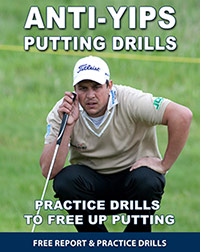
Do You Have an Avoidance Mindset in Putting?
Mark wrote in recently to share his view of the yips cycle…
“The biggest thing I see is a shift in mindset from opportunity (chance to make birdie) to fear (just don’t 3 putt),” Mark said.
Well said. I totally agree… I call this shift into an avoidance mindset.
You focus more on avoiding missing, not three-putting, or making a bogey. You move from thinking about making to trying to not miss.
It’s the same thing as focusing only on the trouble off the tee box and thinking about avoiding hitting it into the junk or trees. This leads to steering and guiding the club.
“You get to the point where you don’t even bother to focus on the line, actually making the putt, and are instead just worried about making a decent stroke, making par and moving on,” Mark said.
“No approach shot is good enough to make you feel comfortable unless the ball is sitting next to the hole. It might start as a fear of missing putts, but it becomes an even greater fear of making a yip stroke in front of your playing partners.”
Yes, when you focus on the outcome or a negative outcome, your fear of missing increases. The worry is about the outcome of missing a putt, feeling disappointed, and thinking you can’t play up to your ability.
But the outcome is just one part of the fear. In the yips cycle, it’s the “aftermath” of the outcome where the majority of the fear is directed.
Most of the time, the aftermath is about what missing means to you:
- Will I look silly?
- Will I embarrass myself?
- Will my playing partners think I suck at golf?
- Will I ever play up to my ability on the course?
- Will I still have fun if I can’t shoot a decent score?
For most golfers, it’s usually about two types of fears:
- The fear of not playing (scoring) to one’s ability
- The fear of embarrassment or worrying about what others think
How do you overcome these fears that cause you to tense up and freeze during your stroke or shot?
First, you have to retrain your mind to focus on what you want to do instead of avoiding missing or three-putting.
This means focusing on a positive image in your mind about the process. This can be focusing on feeling a solid putt, controlling your distance, or hitting the ball on your intended line.
As I wrote last week, you do not want to focus on MAKING A GOOD STROKE!
Second, you have to get past the fear of the aftermath.
In most cases, these fears are irrational, such as, “Others will not respect or like me if I can’t play a good game,” or a similar irrational belief.
If you do better with the first and second tasks above, this will help you free up the putter. When you can free up the putter a bit, you gain a bit of confidence in your method.
When you gain more confidence in your method and feel some freedom back in the stroke, you can turn this into more trust.
And keep in mind, one jerky chip or putt, does not mean you will continue that way all day unless you believe this. Don’t buy into the idea that the first tense shot must mean you have caught the yips for the day!
Related Golf Psychology Articles
- Should You Focus on Your Stroke When Putting?
- Do You Focus on Missing or Making Putts?
- What Should You Focus On While Over The Ball?
Anti-Yips Putting Drills

Do you spend most of your practice time trapped by stroke or mechanics on the practice green? Are you unsure how to practice to help you overcome the putting yips?
With my exclusive drills to free up your putting, previously available to my personal coaching students, you can learn how to use your mind to help you improve your putting performance.
Download my FREE putting report and drills to help you unlock your putting potential today! Please complete the form below to immediately download my FREE putting practice drills:
